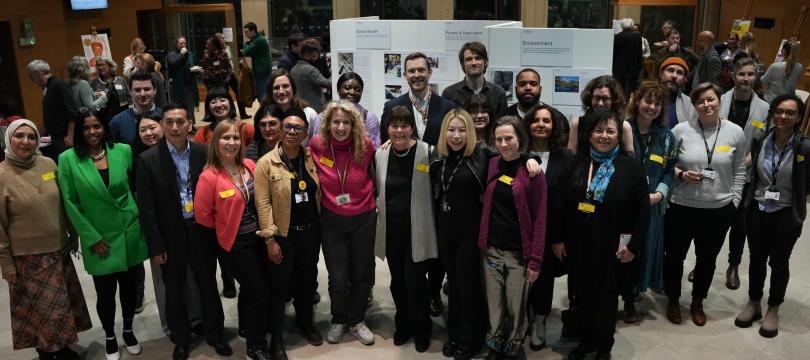An engaged approach to exploring interdisciplinary engagement
Oxford University's newly appointed Fellows in Public Engagement with Research explore how we might embed interdisciplinary public engagement approaches within our higher education institutions, and the opportunities, questions and challenges this raises.
Exploring the opportunities and challenges of interdisciplinary approaches to public engagement with research.

An engaged approach to exploring interdisciplinary engagement
Interdisciplinarity has slowly but steadily percolated the language and practice of academia. That research should incorporate some level of overlap or collaboration with colleagues in other fields is not just desirable, but often expected. This has undoubtedly enriched academic research and provided new perspectives and more holistic understanding of topics traditionally studied in isolation.
When it comes to engaging with the public in higher education institutions though, public engagement (PE) often relates to a specific topic or discipline. One explanation might be that public engagement tends to be structured around departmental or divisions structures. This may be both due to convenience (as these are well defined structures within universities) and funding opportunities (which are traditionally awarded to individual research groups or departments). A positive development is the increasing number of central PE teams, who do excellent work coordinating PE across institutions, and fostering collaboration and interactions.
Why are we interested in interdisciplinary public engagement with research (PER)?
At the University of Oxford, where we are based, there are formalised structures that cross subject areas. Whilst not unique to Oxford, the collegiate system is unusual in preceeding the concept of the department. Colleges are communities that provide a teaching, pastoral and social structure (as well as a physical space) for students and academics across the spectrum of disciplines, from the humanities to science and mathematics. Students and academics are both affiliated with a department and with a college.
In our experience, public engagement is not traditionally seen as part of the life or mission of colleges. No doubt discussions between students and academics on public engagement take place, but PE support and opportunities are generally seen as something that is the responsibility of departments, thereby focusing on specific disciplines.
We have recently been appointed Fellows in Public Engagement with Research at Reuben College, the newest college in Oxford. Still in its embryonic stages, Reuben is re-thinking the role of the college, with the ambitious aim of promoting interdisciplinary research that addresses 21st century challenges focused on four areas: AI and machine learning, environmental sustainability, cellular life and ethics and values. Public engagement is embedded at the core of Reuben College’s mission, demonstrated in part by our election as Fellows, with the same status and influence as the academic fellows.
This is an exciting opportunity for us, but also a challenge. As colleges do not normally “do” public engagement, we have no blueprint to follow. How can public engagement at a college add value in the context of the existing PE structures in a university? One answer could be to focus on the interdisciplinary flavour of public engagement enabled through a college perspective.
What does interdisciplinary PER mean in practice?
This is an exciting focal point, but one open to many interpretations. Different roles and opportunities can lead to very different experiences. One of us has primarily worked in a departmental setting, so encountered few opportunities to promote interdisciplinary PER beyond one, very entertaining, comedy night on the topic of iron. The other works at Oxford University Museum of Natural History, and hence is regularly involved in organising exhibitions and events that bring researchers, collections and exhibits together from across the university and beyond. Conversations with colleagues from within and outside Oxford have raised more questions than answers. What are the differences between inter-, multi- and trans-disciplinary PER? What are the pluses and minuses of these various approaches, and can they be steps in a path to PE that provides deeper explorations of a topic? What are the best examples of interdisciplinary PER? What are the challenges and the benefits, for the publics, researchers and PE professionals? And what are the structural and funding incentives that can encourage this specific flavour of public engagement?
Join us in an exploration of this topic!
We are not the first to think about these questions, but we are interested in learning and sharing with others to explore them. We have therefore joined forces with the NCCPE to invite you to join us in an exploration and reflection on what is interdisciplinary public engagement, but also what it could or should be. We actively seek diverse and varied perspectives, so we don’t want to be too prescriptive on what is within or outside scope. However, we do want to focus the discussion on inter-disciplinary PE, rather than PE that focuses on interdisciplinary research.
Our first step in this exploration is to gather views, perspectives and opinions. We have put together this form as a conduit to share your thoughts on this topic. At the end of the form you will have the opportunity to sign up for an exploratory workshop, which we will be running jointly with the NCCPE on the 14th of April. The thoughts and reflections shared via the form will inform our topics of discussion for the workshop, and will be shared in a summary document. We hope that as a community we can use this as an opportunity to take stock on what is our understanding of interdisciplinary PER, and where we would like to take it next.
By Catarina Vicente and Janet Stott
Fellows in Public Engagement with Research at Reuben College, Oxford
